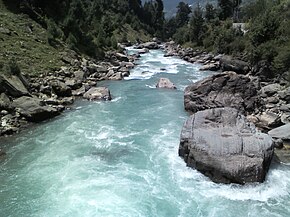Sind River
This article may require cleanup to meet Wikipedia's quality standards. The specific problem is: Unencyclopedic language. (March 2019) |
| Sind River | |
|---|---|
 Sind River | |
| Location | |
| Country | India |
| Union territory | Jammu and Kashmir |
| Region | Kashmir Valley |
| District | Ganderbal |
| Physical characteristics | |
| Source | 34°12′14.860″N 75°35′21.94″E / 34.20412778°N 75.5894278°E |
| • location | Machoi Glacier |
| • elevation | 4,800 m (15,700 ft) |
Jhelum river at Shadipora | |
• elevation | 1,600 m (5,200 ft) |
| Length | 108 km (67 mi) |
| Discharge | |
| • average | 290 m3/s (10,000 cu ft/s) |
The Sind River or the Sindh River is a river in the Ganderbal district of the union territory of Jammu and Kashmir, India. It is a major tributary of the Jhelum River and is 108 km (67 mi) long.
Geography



The Sind River forms the
Surfraw Nallah is a big Nallah which joins the Sind river at Surfraw (Soraf raw). This Nallah is also known for its beauty and fish.
Fish
The Sind River is the natural habitat of trout, and various other fish. The most famous among them are:[8] brown trout,[9] (Salmo trutta) rainbow trout (Oncorynchus mykiss), snow trout (Schizothorax plagiostomus), Shuddgurn and Anyour.
Ecological issues

The
The Fisheries Department and other government agencies have not been able to effectively intervene. Mismanagement of water diversion to power canals is another concern for the survival of fish.[11]
Major projects on the Sind
- Upper Sind Hydroelectric Power project 1st Sumbal.[12]
- Upper Sind Hydroelectric Power Project 2nd Kangan.[13]
- Lower Sind Hydroelectric Power project Ganderbal.
- Rangil water treatment plant.[14]
Major bridges
- Wayil Road Bridge of NH 1D. It is a steel structure bridge for two way vehicular traffic at a time.
- Shithkadi Bridge of NH 1D. It is a steel structure bridge for two way vehicular traffic at a time.
- Hariganiwan Link Road Bridge. It is one of the major steel bridge on River Sind for two way Vehicular traffic at time.
- Ramwari Gund Link Road Bridge is another steel bridge on River Sind & The Construction work is in progress.
- Duderhama Road Bridge, connecting Ganderbal town.
- Bamloora-Fatehpura Bridge connecting Saloora, Bamloora and adjacent villages to Fatehpura, Kujjar & District Hospital.
- Syed Kadal at Pati-Bamloora connecting adjacent villages with Kujjar, Fatehpur & Gadoora.
- Gundrehman Bridge connecting villages of Sherpathri with Gadoora & Srinagar.
- Paribal Shallabugh-Takenwari Bridge (under construction) connecting Ganderbal District with Srinagar and Bandipora.
- Gundroshan Bridge connecting Rabitar village with Gundroshan and Pati Shallabugh and Narayan Bagh.
- Nayaran Bagh Bridge connecting Ganderbal District with Shadipora Town.
See also
- Ganderbal
- Ganderbal District
- Manasbal Lake
References
- ISBN 9780963479860. Retrieved 11 October 2013.
- ISBN 9781402173486. Retrieved 11 October 2013.
- ^ "Upper Sindht II, Water Resources Projects in Indus Basin". nih.ernet.in. Archived from the original on 10 July 2015.
- ^ "Shadipora". wikiedit.org.
- ^ "Sonamarg, two died in river rafting". hindustantimes.com. Archived from the original on 12 September 2012. Retrieved 19 April 2012.
- ^ "Sonamarg, Kashmir-Travel and tourist guide". sonamarg.org.
- ^ "Geography of Jammu and Kashmir State". ikashmir.net.
- ^ "Gippsland Aquaculture Industry Network-Gain". growfish.com.au. Archived from the original on 20 February 2012. Retrieved 22 February 2012.
- ISBN 92-5-104309-4.
- ^ "sand extraction, human waste destroy trout habitat". greaterkashmir.com. Retrieved 26 April 2011.
- ^ "Jammu Kashmir Holidays". jammukashmirholidays.com.
- ^ "Upper Sindh partially resumes generation". greaterkashmir.com. Retrieved 27 April 2010.
- ^ "Upper Sindh Project still not working". greaterkashmir.com. Retrieved 15 September 2009.
- ^ "Rangil Water Treatment Plan to operate soon". kashmirnow.com. Retrieved 18 September 2008.

